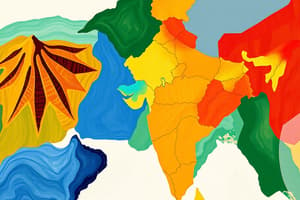Podcast
Questions and Answers
What is the primary purpose of fieldwork in physical geography?
What is the primary purpose of fieldwork in physical geography?
- To simulate and predict environmental processes
- To contribute to climate sciences and disaster mitigation
- To directly observe and measure geographic features (correct)
- To use computerized tools to analyze geographic data
Which course would be most beneficial for a student interested in studying physical geography?
Which course would be most beneficial for a student interested in studying physical geography?
- Quantitative Methods
- Cultural Geography
- Remote Sensing (correct)
- Introduction to Human Geography
How does physical geography contribute to environmental protection?
How does physical geography contribute to environmental protection?
- By understanding the forces that shape our planet (correct)
- By visualizing geographic data with computerized tools
- By predicting climate change impacts accurately
- By managing environmental resources effectively
Which field benefits directly from the use of geographic information systems (GIS)?
Which field benefits directly from the use of geographic information systems (GIS)?
What distinguishes physical geography from environmental modeling?
What distinguishes physical geography from environmental modeling?
What is the primary focus of physical geography?
What is the primary focus of physical geography?
Which of the following is NOT considered an element of physical geography?
Which of the following is NOT considered an element of physical geography?
What does hydrology study within physical geography?
What does hydrology study within physical geography?
Which research method involves using satellite imagery to collect data in physical geography?
Which research method involves using satellite imagery to collect data in physical geography?
What does the study of atmospheric systems focus on in physical geography?
What does the study of atmospheric systems focus on in physical geography?
Flashcards are hidden until you start studying
Study Notes
Uncovering Physical Geography: Exploring the Landscape
Physical geography, a subfield of geography, is the study of Earth's natural systems, including its landforms, atmospheric processes, and natural resources. This dynamic field examines how these elements interact and shape our planet.
Elements of Physical Geography
Physical geographers unravel the intricate relationships between geological, hydrological, and climatic systems to understand the evolution of our planetary surface. Key elements within this discipline include:
- Landforms: The study of topographic features such as mountains, valleys, and coastal zones, and the processes that shape them, like erosion and deposition.
- Atmosphere: The investigation of atmospheric systems and processes, such as wind patterns, precipitation, and temperature variations, and their impacts on Earth's landscapes.
- Climate: The examination of Earth's climate systems, including temperature, humidity, and precipitation regimes, and how they affect ecosystems and societies.
- Hydrology: The study of Earth's water systems, including water bodies, water movement, and water availability, and their effects on the landscape.
Research Methods and Skills
Physical geographers employ a variety of techniques and methods to conduct their research, including:
- Remote Sensing: The use of satellite imagery and aerial photography to collect data about landforms, vegetation, and other features.
- Fieldwork: The direct observation and measurement of geographic features, such as topographic mapping or hydrological surveys.
- GIS (Geographic Information Systems): The use of computerized tools to store, manage, analyze, and visualize geographic data.
- Environmental Modeling: The use of mathematical models to simulate and predict environmental processes and their impacts.
Physical geography also requires a strong foundation in quantitative and qualitative methods, as well as regional and environmental studies. Recommended college courses for physical geographers include:
- Introduction to Physical Geography
- Geographic Information Systems
- Remote Sensing
- Environmental Management
- Quantitative Methods
- Human Geography
- Regional Geography
- World Geography
- Qualitative Methods
- Cultural Geography
Impact and Applications
Physical geography is more than just learning about the natural world. It helps us understand the forces that shape our planet, which in turn informs our decisions about land use, resource management, and environmental protection. Physical geographers contribute to a wide range of fields such as climates sciences, environmental management, and disaster mitigation.
As an interdisciplinary field, physical geography is vital to our understanding of complex issues like climate change, resource scarcity, and land-use planning. By uncovering the physical processes that shape our planet, physical geographers help us navigate the challenges that lie ahead.
In summary, physical geography is a diverse and dynamic discipline that combines a deep appreciation for Earth's natural systems with advanced research methods and skills. As a subfield of geography, it is essential for addressing the environmental challenges that we face today.
Studying That Suits You
Use AI to generate personalized quizzes and flashcards to suit your learning preferences.




